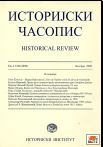Градитељско дело, контекст, значење: приступи проучавању на примеру архитектуре Моравске Србије
Architectural Work, Context, Meaning: Approaches to the Study of Architecture of Moravian Serbia
Author(s): Dejan CrnčevićSubject(s): History
Published by: Istorijski institut, Beograd
Keywords: Moravian Serbia; Late Medieveal architecture; work; context; meaning; formal analysis; analysis of the strucutre of meaning
Summary/Abstract: The art of the last period of the Serb Medieval state, known as the Art of Morava Serbia, was and remains one of the most complex questions of the Serbian Medieval art. So far, it was evaluated in a very wide range — from being labeled the most original and only truly national art style of Medieval Serbia, to being reduced to mere eclecticism, art of local importance, lacking full development and major changes. Such conclusions were especially present when evaluating the architecture of the Morava Serbia. A more balanced perspective is rendered more difficult by the fact that the wider frame, where it undoubtedly belongs as an important segment — the Late Byzantine architecture — represents another very complex issue. Scholarly research in the Morava Serbia architecture began in the early days of the establishment of art history in Serbia, during the last three decades of the 19th century. Knowledge presented at the time was only within the limits of basic facts about the past, and the look of the churches known at the time. Among the first synthetic works on Medieval Serbia architecture by European researchers, especially influential was Gabriel Millet's L'ancien art serbe. Les églises (Paris, 1919). This French scholar established a model of describing Serb Medieval architecture chronologically, territorially, and in wholes stylistically homogenous, which he labeled “schools,” whichhistorically followed one after the other, in an evolutionary sequence, from simpler to more complex architectural organisms. A change in perception occurred in mid-1960s, in works of the two leading researchers at the time, Vojislav Korać and Vojislav J. Đurić. Finally, after several decades of study of Morava Serbia architecture and sculpture, there is a first synthetic work, by Vladislav Ristić (Moravska arhitektura, Kruševac, 1996). However, this book, although very important, still represents only modernized form of the traditional typological classification, established by Gabriel Millet. Thus, it confirms the degree in which even contemporary science remains captive to old concepts and models of perceiving Morava Serbia architecture. Fortunately, some more recent monographs display use of qualitatively different methodological takes on its study (I. Stevović, Kalenić. Bogorodična crkva u arhitekturi poznovizantijskog sveta, Belgrade, 2006). By analyzing these works, one could note that the efforts of scholars for the most part went within the framework determined by studying the work’s origin and existence, as well as the analysis of its formal characteristics. The possibility for widening of the interpretative horizon is necessarily seen in perception of its context, understood as the general whole of all the relations that the work establishes with its environment. Based on this, the finally complex structure could be seen in part of the stored meanings, built in several layers and with rich texture of mutual relations.
Journal: Историјски часопис
- Issue Year: 2008
- Issue No: 57
- Page Range: 93-106
- Page Count: 14
- Language: Serbian

